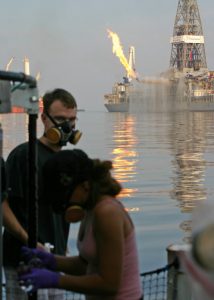Modelling Study Demonstrates Dispersants Lowered Health Risks during Oil Spill
– SEPTEMBER 14, 2017
Scientists used data collected during the Deepwater Horizon spill to validate a model simulation of the physical and chemical behavior of oil and gas rising from the wellhead to the ocean surface. Using scenarios of dispersant and no-dispersant use, the model indicated that dispersant injection reduced the emission of several toxic compounds by 28% in the atmosphere, including a 2,000-fold decrease in the predicted mass flow rate of benzene emissions. The simulation results rationalize the effectiveness of subsea dispersant injection as a response strategy for reduced volatile organic compounds exposure by response personnel. The researchers published their findings in the Proceedings of the National Academy of Sciences journal: Petroleum dynamics in the sea and influence of subsea dispersant injection during Deepwater Horizon.
The unprecedented use of chemical dispersants at the spill source, intended to decrease shoreline oiling, elicited public concern about potential adverse effects such as toxicity from the chemicals in the dispersants. The modeling work done by this study’s team provides an expanded understanding of a potential positive effect of subsea dispersant injection during the spill.
The team developed a comprehensive fluid dynamics and chemistry model of petroleum fluid in the oceans called the Texas A&M Oil spill Calculator or TAMOC, which NOAA has included as a module in the oil forecasting tool GNOME. Using 279 simulated chemical components for a representative day (June 8, 2010) after the riser pipe was pared at the wellhead, the researchers modeled the buoyant jet of petroleum liquid droplets, gas bubbles, and entrained seawater.
Combined results from the model simulation and water column measurements showed 24% of the released petroleum went into a stable deep-water intrusion (900-1300 meters depth). With subsea dispersant injection, the median initial diameters decreased 3.2 fold for oil droplets and 3.4 fold for gas bubbles, which increased dissolution of ascending petroleum fluids by 25% compared to the no-dispersant case. The faster dissolution increased the simulated flows of water-soluble compounds into biologically sparse deep water by 55% while decreasing the flows of several harmful compounds into biologically rich surface water.
“Several toxic and volatile compounds, including benzene and toluene, are in the sweet spot of compounds affected by the dispersant,” explained study author Scott Socolofsky. “More soluble compounds remain dissolved in the ocean and heavier substances rise to the sea surface whether dispersants are used or not. It is these carcinogenic BTEX compounds that were the most affected by dispersant usage during the Deepwater Horizon response.”
Study author J. Samuel Arey said that the effect of subsea dispersant injection is complicated and requires a careful analysis of all effects. “This is one reason that the National Academies of Science has commissioned a committee to conduct a holistic review of present knowledge. Whether or not dispersants were effective depends on what you expect them to do.”
The authors noted that the study does not predict the exact effect of dispersant use for future spills and that whether and how dispersants are used in the future depends on the outcomes of this and many other studies. However, they expect that this and other ongoing science and engineering studies will improve how dispersants can be used subsea to optimize their dosage and to achieve other important outcomes, such as reducing the amount of oil reaching the ocean surface layer.
Data are publicly available through the Gulf of Mexico Research Initiative Information & Data Cooperative (GRIIDC) at R1.x138.077:0028.
The study’s authors are Jonas Gros, Scott A. Socolofsky, Anusha L. Dissanayake, Inok Jun, Lin Zhao, Michel C. Boufadel, Christopher M. Reddy, and J. Samuel Arey.
************
This research was made possible in part by a grant from the Gulf of Mexico Research Initiative (GoMRI) to the Center for the Integrated Modeling and Analysis of Gulf Ecosystems II (C-IMAGE II), the Dispersion Research on Oil: Physics and Plankton Studies II (DROPPS II) consortium, the Deepsea to Coast Connectivity in the Eastern Gulf of Mexico (DEEP-C) consortium, and to the project The State-of-the-Art Unraveling of the Biotic and Abiotic Chemical Evolution of Macondo Oil: 2010-2018. Other funding sources include the National Science Foundation (Grants OCE-0960841, RAPID OCE-1043976, CBET-1034112, and EAR-0950600).
The Gulf of Mexico Research Initiative (GoMRI) is a 10-year independent research program established to study the effect, and the potential associated impact, of hydrocarbon releases on the environment and public health, as well as to develop improved spill mitigation, oil detection, characterization and remediation technologies. An independent and academic 20-member Research Board makes the funding and research direction decisions to ensure the intellectual quality, effectiveness and academic independence of the GoMRI research. All research data, findings and publications will be made publicly available. The program was established through a $500 million financial commitment from BP. For more information, visit https://gulfresearchinitiative.org/.
© Copyright 2010-2017 Gulf of Mexico Research Initiative (GoMRI) – All Rights Reserved. Redistribution is encouraged with acknowledgement to the Gulf of Mexico Research Initiative (GoMRI). Please credit images and/or videos as done in each article. Questions? Contact web-content editor Nilde “Maggie” Dannreuther, Northern Gulf Institute, Mississippi State University (maggied@ngi.msstate.edu).






